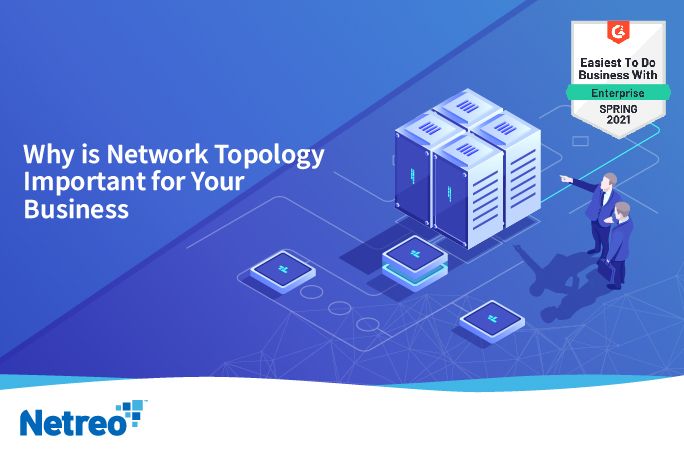If you’d like to learn more about how Netreo can help you, request a demo to speak with one of our engineers.

With more and more businesses depending on technology, networking can get more and more complex. Therefore, a network topology plan, which gives you a clear oversight of what’s at stake, will always be useful.
But what are the benefits of having a topology system in place? How can it help a business with its performance management in real-time? There are a variety of network monitoring tools out there that practice a topological approach to support. In this guide, we’ll examine why they are so crucial in the modern age.
Put simply, network topology is an overview of your computer network. Topological diagrams and dashboards allow you to see all of your networked devices in one simple space. ‘Simple,’ however, is a term that perhaps underplays it. Even the smallest of businesses and enterprises have remarkably intricate network demands!
Topology also refers to both the physical connectivity between devices and how we use data within our networks. Here lays the difference between physical topology and logical topology.
Physical topology, as you may expect, revolves around how nodes connect. It is the overview of each cable, wire, and component in your network and how it all comes together.
Logical topology goes beyond the physical aspect. It includes an overview of the data’s journey within your specific network. It looks at how devices respond to each other and how much data travels between the points.
Therefore, you may already have some idea of how effective topology can be for business users. However, we need to look a little more closely at the specifics.
Simply put, network topology helps us understand two crucial things. It allows us to understand the different elements of our network and where they connect. Two, it shows us how they interact and what we can expect from their performance.
Performance management, therefore, is the key to topology, no matter the size or nature of a network and its various devices. There are also multiple different types of topology beyond the physical and logical classification.
For example, some business networks may adopt a ring topology, allowing managers to transfer data cyclically. Tree topology, meanwhile, is useful if you have a central hub and multiple secondaries. This will enable you to connect various parties on a network that branch off from one another.
Hybrid topology, meanwhile, incorporates the best of several models. It may allow scalability and flexibility, for example, to move between point to point systems and ring topologies.
Types aside, we need to consider the direct effects and benefits of having topologies in place. Here are a few examples.

Onboarding new staffers and engineers is not always simple without clear oversight of your network. Topologies, providing you are working with experienced people, can help act as ‘roadmaps’ for understanding how everything connects.
It is entirely possible to produce a topology as a guiding diagram. Furthermore, this can help engineers new to your infrastructure understand the knock-on effects that each event can have. Crucially, it’s giving engineers the keys to the vehicle when they already know how to drive.
A good topology that works well in practice will help you create ‘systems.’ These can be helpful to use as reference points. Once again, topology diagrams work brilliantly as roadmaps.
For smoother communication between staff and clients, you may use topological diagrams to set templates. These systems help to keep everyone working from the same concept. If everyone has a clear idea of cause and effect, there is greater accountability, too.
You may even choose to use diagrams to help establish guides and manuals on route, too.
Perhaps one of the most important knock-on effects of topology is cost-effectiveness. A clear roadmap can help you find network operations that aren’t efficient enough. You may be able to remove some elements from the cycle altogether!
A more efficient topology means a more productive workforce. The mathematics here, of course, states that you can expect to deliver more quality work in a shorter time. The knock-on effect is higher revenue and more room to attend to demand. It is harnessing growth!
Topologies also help us to identify problem areas in our networks. For example, we may experience packet loss at points A through F. Which of the points between the two are letting down the network?
Topology allows you to home in on weak links in the chain. You can narrow down the field too, for example, points C or D, and make adjustments.
Topology also ensures that you allocate enough resources to each party in the network. A real-time monitoring solution will allow you to spot a problem and directly engage with it.
It could have the potential to cut down on diagnostic time. Again, this helps to increase productivity and ensure that your network is working at peak efficiency.
Not always. Computer networks going back decades may depend on traditional point to point systems. Other operators may choose the ring or star topology approach without giving it much concern.
However, for networks to operate at their best, we must focus on how to arrange them for the better. As data centers and increasing points in the network can make things difficult to manage, smarter monitoring is vital.
A network monitoring solution with a topological approach may help to boost productivity and save money. It may also help to free up resources and to help staffers engage quicker with the broader network.
Therefore, in one form or another, network topology is ideal for businesses of all shapes and sizes. There are plenty of different topology styles to adopt. Hybrid models, for example, can scale endlessly – if this is the support you require!
–
If you’d like to learn more about how Netreo can help you, request a demo to speak with one of our engineers.